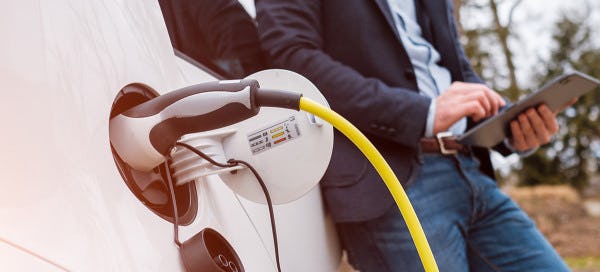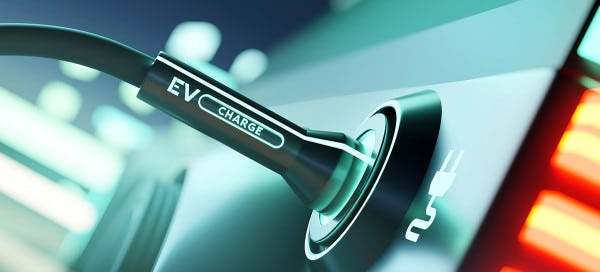With such rapidly evolving technology, some confusion is bound to occur, especially when it comes to the details of EV charging. There are three different types of widely used charging stations, each with its own benefits and drawbacks. Let’s explore.
Level 1 Chargers
Level 1 EV chargers, which run through a standard 120-volt wall outlet, are the slowest option for charging your EV battery. They are convenient since they require no additional installation but take a very long time to charge. On average, a Level 1 charger will charge an EV battery at a rate of 5 miles of range per hour. For a long-range vehicle, such as a Tesla or Chevy Volt, it can take close to 40 hours to fully charge from a dead battery. Level 1 chargers can give you that extra boost when you don't have access to a Level 2 or 3, but they are not usually powerful enough for daily commuters.
Level 2 Chargers
Level 2 chargers are the most popular among EV owners due to the increased charging speed and ample availability. These are standard at electric vehicle charging stations across the country and can easily be installed in your own home. They rely on a 240-volt output, like a washing machine, and can charge your EV almost five times faster than a Level 1 charging station, or about 25 miles of range per hour. Installing a Level 2 charger in your own home is the most reliable way to ensure you have a fully charged electric car every day.
Level 3 Chargers
Level 3 chargers are by far the fastest option for charging your electric vehicle but will cost a lot more to use as a result. They rely on a power output of 400 volts or more, which can charge a long-range EV battery in less than 2 hours (a rate of approximately 150 miles of range per hour of charging). This is an immense amount of power and comes with a few caveats.
Since fast chargers of this voltage are not suitable for home installation, you will only be able to access a Level 3 charger from roadside charging stations. Furthermore, you’ll have to pay to use them—it can typically cost around $20-30 to fully charge a dead EV battery on a public fast charger. Frequently using a fast charger will also increase the rate at which your EV's battery capacity declines, so it is recommended to only use this type of charger when necessary.
Keep in mind that not all EV batteries will work with this level of charging power. Most short-range batteries such as the Chevy Spark cannot accept the high voltage associated with fast charging. Refer to your owner's manual to be sure your electric vehicle is equipped for fast charging before attempting to use one.
Electric Vehicle Charging Plugs
The charging connector used to plug into your electric vehicle will vary depending on the charging speed and vehicle model. Level 1 and 2 chargers will always use a J1772 port, a type of charging connection that comes equipped on all EVs sold in the U.S. after 2000. When using a Level 3 fast charger, there are three classes of plugs which may be used by your EV.
The CCS connector is a combination of the J1772 port, with an added dual-pin connection just below the J-port to allow for fast charging. This is the most used fast charging port by automakers in North America, including Ford, General Motors, Chrysler, Dodge, Jeep, Honda, Mercedes and more.
CHAdeMO is a proprietary plug compatible with DC fast charging. This connection is the standard in Japan, but only used by Nissan and Mitsubishi in North America. Unless you own a vehicle made by one of these two companies, your EV will most likely be compatible with a CCS port.
That is, unless you own a Tesla. The major electric vehicle manufacturer has developed its own system of charging stations that only work with the proprietary Tesla connector. The Tesla plug also supports all levels of charging, so you only have to be concerned with one type of connector. Tesla’s vehicles still work with non-Tesla brand charging stations, but you will need an adapter to plug in to the J-port or CCS connector.
EV Charging at Home
While you can simply charge your electric vehicle with a Level 1 charger on any 120-volt wall outlet, there is a huge advantage to installing a Level 2 charger in your own home. These chargers take a similar amount of power to a washing machine, but they will charge your vehicle about five times quicker than a lower-level charger. A long-distance EV battery will take close to 40 hours to fully charge on a Level 1, so having access to a Level 2 every day will ensure your car is always ready to go.
Installing a Level 2 charger in your home will typically involve adding a 240-volt connection from the breaker panel to your charging location. The parts and labor for professional installations of electric vehicle charging stations can cost anywhere from $1700 to $2700. However, there are credits and rebates that can help you lower this price.
If you choose to install an electric vehicle charger in your own home, you are eligible for the Alternative Fuel Infrastructure tax credit, which will cover 30% of the cost for residential installations (up to a maximum of $1,000). This applies to the cost of the charger, as well as the installation job. There are also state-specific rebates and programs that can further decrease the costs associated with electric vehicle charging.
Beyond the EV tax credits and rebates, there are even more benefits for drivers. HOV usage and preferred parking privileges will save you time on your commute, while reduced gasoline and maintenance costs will help lower your transportation budget. The ongoing costs of powering an electric vehicle are clearly a plus, but there is still a dilemma associated with high energy usage.
While grid power is still commonly produced from fossil fuels, many electric vehicle owners are switching to renewable energy plans backed by solar and wind power, to clean up their energy usage.
Luckily, an increasing number of energy providers are offering green energy plans. Companies like Rhythm are leading this movement in Texas, where residents have the power to choose how they power their EV. To learn more about electric vehicles, visit our EV FAQ page. You can also compare the average costs that come with EV ownership and browse EV models in our Electric Vehicle Hub.



